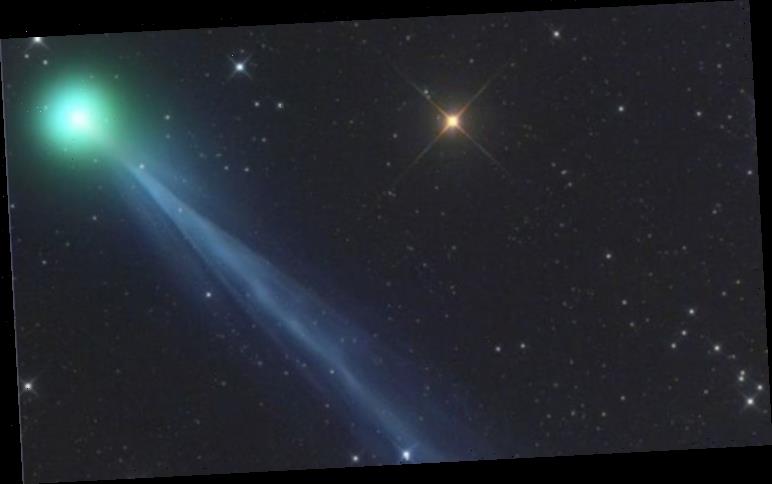Comet SWAN (C/2020 F8) was discovered on April 11 which, like ATLAS was meant to, will arrive at the orbit of Mercury in late May. The comet is now so close to Earth, it is now visible to the naked eye for those in the southern hemisphere, astronomers have revealed.
New Zealand resident John Drummond told Space Weather: “Hi, I just came in from observing C/2020 F8 with the naked eye (2020 Apr 29 UT). It seems to have increased brightness dramatically since I last observed it a few nights ago.
“No tail was obvious through 15 x 80 binoculars. Awesome to see a naked eye comet again!”
Comet SWAN will continue to make its way closer to Earth. On May 12, it will be its closest, being just 0.56 astronomical units from Earth – roughly half the distance between the Sun and our planet.
Space Weather said: “If current trends continue, the comet will brighten to 3rd magnitude or better, similar to the stars of the Pleiades.
“Observers in the southern hemisphere will have little trouble seeing it as it glides through the constellation Pisces.”
Comet SWAN was first discovered by Michael Mattiazzo of Swan Hill, Victoria, Australia, when he was analysing data from the Solar and Heliospheric Observatory’s (SOHO) SWAN instrument – hence the name.
SWAN’s job is to scan the solar system for hydrogen, so for it to see the comet suggests Comet SWAN is currently emitting a lot of hydrogen at the moment.
Karl Battams of the Naval Research Lab in Washington DC said: “For SWAN to see a comet, it means the comet must be producing a fairly significant amount of hydrogen.
“This is usually in the form of water-ice. It’s extremely likely that Comet SWAN is in ‘outburst’ mode.
“That is, some major eruption happened to this otherwise small and faint comet, releasing a massive cloud of hydrogen-rich volatiles.
“SWAN is picking up on this sudden dump of hydrogen into the inner solar system.”
However, experts are unsure if the comet will remain until May 12. Mr Battams, who correctly predicted the demise of Comet ATLAS, believes this scenario is unlikely.
DON’T MISS
Asteroid discovery: ‘Oumuamua was part of larger body
Comet ATLAS 2020: Comet Y4 breaking up as it approaches the Sun
Comet ATLAS: Comet could be as bright as the MOON as it nears the Sun
He continued: “I doubt that the comet will maintain its current impressive appearance, and will quite possibly fade away soon. But we’ve only been viewing it for a couple of days, so no one knows.”
Astronomers had hoped Comet ATLAS could hold out until it got close enough to the Sun so it would be as visible in the night sky as Venus, which looks like a bright star.
However, the latest observations have revealed it has begun to fragment.
Astronomers believed it was crumbling apart as its brightness began to dip, which suggested it was not as big as it once was.
Researchers from the Lulin One-meter Telescope in Taiwan confirmed it was falling apart, with one fragment 3,400 km ahead of the trailing pair.
Source: Read Full Article




